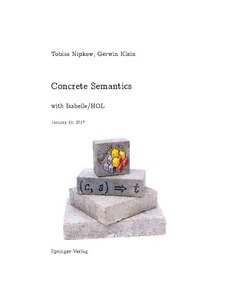Table Of ContentTobias Nipkow, Gerwin Klein
Concrete Semantics
with Isabelle/HOL
January 10, 2017
Springer-Verlag
I will not allow books to prove anything.
Jane Austen, Persuasion
Preface
This book is two books. Part I is a practical introduction to working with
the Isabelle proof assistant. It teaches you how to write functional programs
and inductive definitions and how to prove properties about them in Isa-
belle’s structured proof language. Part II is an introduction to the semantics
of imperative languages with an emphasis on applications like compilers and
program analysers. The distinguishing features are that every bit of mathe-
maticshasbeenformalizedinIsabelleandthatmuchofitisexecutable.PartI
focusses on the details of proofs in Isabelle. Part II can be read even without
familiarity with Isabelle’s proof language: all proofs are described in detail
but informally. The Isabelle formalization, including the proofs, is available
online: all the material, including accompanying slides, can be downloaded
from the book’s home page http://www.concrete-semantics.org.
Although the subject matter is semantics and applications, the not-so-
hidden agenda is to teach the reader two things: the art of precise logical
reasoningandthepracticaluseofaproofassistantasasurgicaltoolforformal
proofs about computer science artefacts. In this sense the book represents a
formal approach to computer science, not just semantics.
Why?
This book is the marriage of two areas: programming languages and theo-
rem proving. Most programmers feel that they understand the programming
language they use and the programs they write. Programming language se-
mantics replaces a warm feeling with precision in the form of mathematical
definitionsofthemeaningofprograms.Unfortunatelysuchdefinitionsareof-
tenstillatthelevelofinformalmathematics.Theyarementaltools,buttheir
informalnature,theirsize,andtheamountofdetailmakesthemerrorprone.
SincetheyaretypicallywritteninLATEX,youdonotevenknowwhetherthey
VI Preface
wouldtype-check,letalonewhetherproofsaboutthesemantics,e.g.,compiler
correctness, are free of bugs such as missing cases.
Thisiswheretheoremprovingsystems(or“proofasistants”)comein,and
mathematical(im)precisionisreplacedbylogicalcertainty.Aproofassistantis
a software system that supports the construction of mathematical theories as
formallanguagetextsthatarecheckedforcorrectness.Thebeautyisthatthis
includes checking the logical correctness of all proof text. No more ‘proofs’
that look more like LSD trips than coherent chains of logical arguments.
Machine-checked (aka “formal”) proofs offer the degree of certainty required
for reliable software but impossible to achieve with informal methods.
In research, the marriage of programming languages and proof assistants
has led to remarkable success stories like a verified C compiler [53] and a
verified operating system kernel [47]. This book introduces students and pro-
fessionals to the foundations and applications of this marriage.
Concrete?
(cid:15) The book shows that a semantics is not a collection of abstract symbols
on sheets of paper but formal text that can be checked and executed
by the computer: Isabelle is also a programming environment and most
of the definitions in the book are executable and can even be exported
as programs in a number of (functional) programming languages. For a
computer scientist, this is as concrete as it gets.
(cid:15) Muchofthebookdealswithconcreteapplicationsofsemantics:compilers,
type systems, program analysers.
(cid:15) Thepredominantformalisminthebookisoperationalsemantics,themost
concrete of the various forms of semantics.
(cid:15) Foundations are made of concrete.
Exercises!
The idea for this book goes back a long way [65]. But only recently have
proofassistantsbecomematureenoughforinflictingthemonstudentswithout
causingthestudentstoomuchpain.Neverthelessproofassistantsstillrequire
very detailed proofs. Learning this proof style (and all the syntactic details
that come with any formal language) requires practice. Therefore the book
contains a large number of exercises of varying difficulty. If you want to learn
Isabelle, you have to work through (some of) the exercises.
A word of warning before you proceed: theorem proving can be addictive!
Preface VII
Acknowledgements
This book has benefited significantly from feedback by John Backes, Harry
Butterworth,DanDougherty,AndrewGacek,FlorianHaftmann,PeterJohn-
son, Yutaka Nagashima, Andrei Popescu, René Thiemann, Andrei Sabelfeld,
DavidSands,SeanSeefried,HelmutSeidl,ChristianSternagelandCarlWitty.
Ronan Nugent provided very valuable editorial scrutiny.
Thematerialinthisbookhasbeenclassroom-testedforanumberofyears.
Sascha Böhme, Johannes Hölzl, Alex Krauss, Peter Lammich and Andrei
Popescu worked out many of the exercises in the book.
Alex Krauss suggested the title Concrete Semantics.
NICTA,TechnischeUniversitätMünchenandtheDFGGraduiertenkolleg
1480 PUMA supported the writing of this book very generously.
We are very grateful for all these contributions.
Munich TN
Sydney GK
October 2014
Contents
Part I Isabelle
1 Introduction............................................... 3
2 Programming and Proving................................. 5
2.1 Basics.................................................. 5
2.2 Types bool, nat and list.................................. 7
2.3 Type and Function Definitions ............................ 15
2.4 Induction Heuristics ..................................... 19
2.5 Simplification ........................................... 21
3 Case Study: IMP Expressions ............................. 27
3.1 Arithmetic Expressions................................... 27
3.2 Boolean Expressions ..................................... 32
3.3 Stack Machine and Compilation........................... 35
4 Logic and Proof Beyond Equality.......................... 37
4.1 Formulas ............................................... 37
4.2 Sets ................................................... 38
4.3 Proof Automation ....................................... 39
4.4 Single Step Proofs ....................................... 42
4.5 Inductive Definitions..................................... 45
5 Isar: A Language for Structured Proofs.................... 53
5.1 Isar by Example......................................... 54
5.2 Proof Patterns .......................................... 56
5.3 Streamlining Proofs...................................... 58
5.4 Case Analysis and Induction .............................. 61
X Contents
Part II Semantics
6 Introduction............................................... 73
7 IMP: A Simple Imperative Language ...................... 75
7.1 IMP Commands......................................... 75
7.2 Big-Step Semantics ...................................... 77
7.3 Small-Step Semantics .................................... 85
7.4 Summary and Further Reading............................ 90
8 Compiler .................................................. 95
8.1 Instructions and Stack Machine ........................... 95
8.2 Reasoning About Machine Executions...................... 98
8.3 Compilation ............................................ 99
8.4 Preservation of Semantics ................................102
8.5 Summary and Further Reading............................112
9 Types .....................................................115
9.1 Typed IMP.............................................117
9.2 Security Type Systems ...................................128
9.3 Summary and Further Reading............................140
10 Program Analysis .........................................143
10.1 Definite Initialization Analysis ............................145
10.2 Constant Folding and Propagation.........................154
10.3 Live Variable Analysis ...................................164
10.4 True Liveness ...........................................172
10.5 Summary and Further Reading............................178
11 Denotational Semantics....................................179
11.1 A Relational Denotational Semantics.......................180
11.2 Summary and Further Reading............................188
12 Hoare Logic ...............................................191
12.1 Proof via Operational Semantics ..........................191
12.2 Hoare Logic for Partial Correctness ........................192
12.3 Soundness and Completeness .............................203
12.4 Verification Condition Generation .........................208
12.5 Hoare Logic for Total Correctness .........................212
12.6 Summary and Further Reading............................215
Contents XI
13 Abstract Interpretation....................................219
13.1 Informal Introduction...................................220
13.2 Annotated Commands ..................................224
13.3 Collecting Semantics....................................225
13.4 Abstract Values ........................................236
13.5 Generic Abstract Interpreter.............................241
13.6 Executable Abstract States ..............................253
13.7 Analysis of Boolean Expressions..........................259
13.8 Interval Analysis .......................................264
13.9 Widening and Narrowing................................270
13.10 Summary and Further Reading...........................279
A Auxiliary Definitions ......................................281
B Symbols ...................................................283
C Theories...................................................285
References.....................................................287
Index..........................................................293

